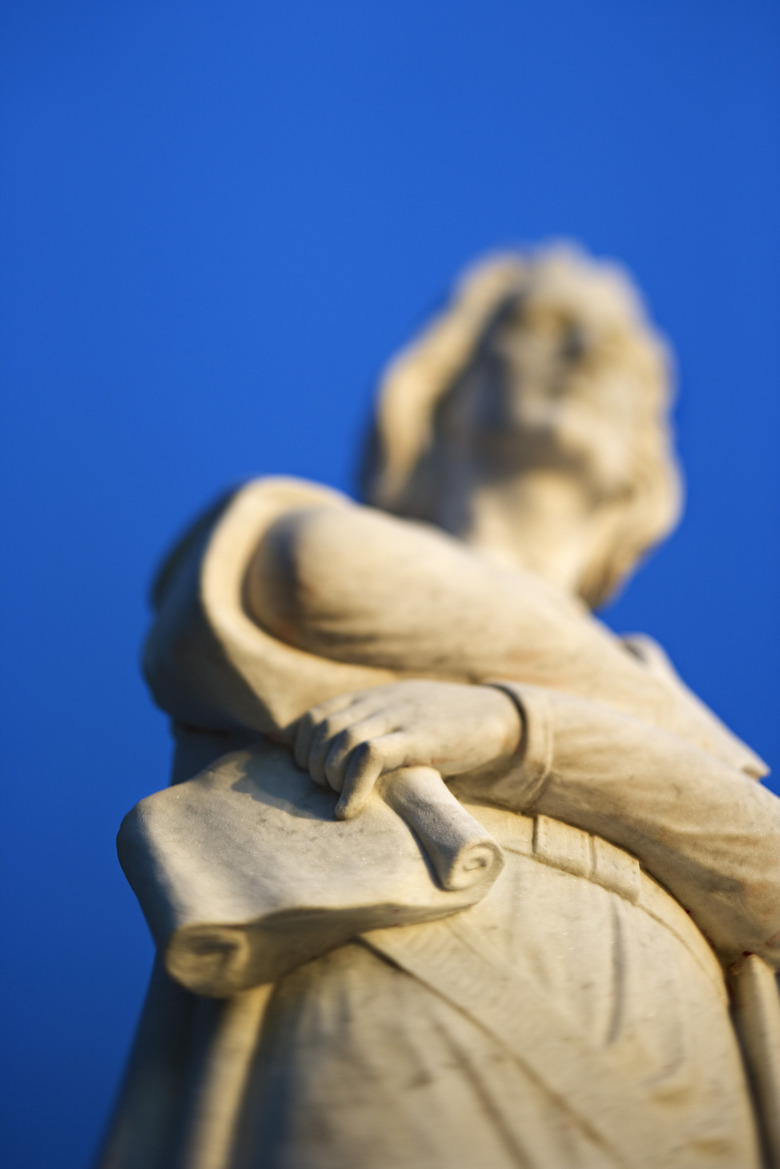How Does Acid Rain Affect Buildings & Statues?
Acid rain can ruin buildings and statues by stripping away the material and corroding metal that makes up these structures. Architects chose limestone, marble, steel and brass as durable materials intended to resist the elements. But to their surprise, chemical reactions between the acid rain and building materials led to visible deterioration over time, dissolving structures like water does to a sugar cube.
Acid Rain Basics
Acid Rain Basics
Chemists measure the corrosive power of acids with the pH scale, in which smaller numbers indicate stronger acids. The pH of pure water is 7 or neutral, while the pH of a weak acid, like vinegar, runs between 2 to 3. Normal rain is not neutral like pure water but is slightly acidic at around 5.6 pH or lower. Industrial areas have reported an acid rain below a 2.4 pH. Rain water becomes weakly acidic because carbon dioxide gas in the atmosphere reacts with water to form carbonic acid. But sulfur oxide and nitrogen oxide molecules resulting from industrial pollution and automobile exhaust react with rainwater to form strong acids. These molecules react together to cause acid rain.
Deteriorating Buildings
Deteriorating Buildings
Acid rain damages buildings and structures because it dissolves the stone or corrodes the metal that is exposed to the weather. Before people became aware of the problems that acid rain caused, they often used metals, limestone and marble as building materials exposed to rain and fog. Some of these materials contain calcium carbonate or calcium-based compounds, which can be dissolved by acid rain. Sandstone holds up better to acid rain, but can be marred by black surface deposits over time.
Faceless Statues
Faceless Statues
Old statues, monuments and tombstones are vulnerable to acid rain because they were made of limestone. Over decades of exposure to acid rain, the details of a statue can be lost, slowly turning them into featureless blobs. Acid rain has also attacked the chiseled words on some tombstones, rendering them unreadable. Although metal statues resist physical deterioration from acid rain better than stone, they can develop discoloration and streaking.
Corroded Metals
Corroded Metals
Acid rain can damage buildings and bridges with metallic parts that are exposed to rain and fog. Not only does acid rain aggressively dissolve calcium in stone, but it corrodes certain types of metal. Vulnerable metals include bronze, copper, nickel, zinc and certain types of steel. A study in the journal "Water, Air, and Soil Pollution" by the University of Hong Kong reported that artificial acid rain with a pH of 3.5 could corrode mild steel, galvanized steel, stainless steel 304 and red brass. Mild steel and stainless steel were the most vulnerable. But all four metals were increasingly corroded as the researchers used stronger and stronger acid rain.
References
- South Asian Journal of Tourism and Heritage: Science Behind Acid Rain – Analysis of Its Impacts and Advantages on Life and Heritage Structures
- International Association of Certified Home Inspectors: Acid Rain and Inspectors – Buildings at Risk
- Elmhurst College Chembook: Acid Rain Effects on Buildings
- Water, Air, and Soil Pollution: Corrosion of Construction Metals Under Simulated Acid Rain/Fog Conditions With High Salinity
Cite This Article
MLA
Ph.D., David H. Nguyen,. "How Does Acid Rain Affect Buildings & Statues?" sciencing.com, https://www.sciencing.com/acid-rain-affect-buildings-statues-22062/. 9 March 2018.
APA
Ph.D., David H. Nguyen,. (2018, March 9). How Does Acid Rain Affect Buildings & Statues?. sciencing.com. Retrieved from https://www.sciencing.com/acid-rain-affect-buildings-statues-22062/
Chicago
Ph.D., David H. Nguyen,. How Does Acid Rain Affect Buildings & Statues? last modified August 30, 2022. https://www.sciencing.com/acid-rain-affect-buildings-statues-22062/
